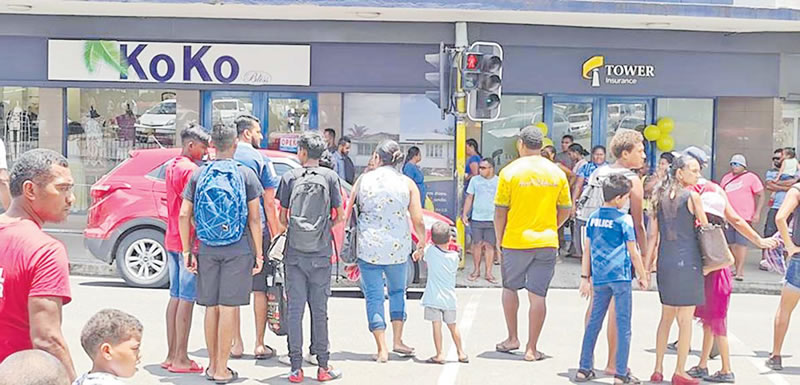What on earth could Suva based women’s clothing retailer KoKo have in common with the world’s largest clothing retailer ZARA?
Operating from its beautifully fitted shop just around the corner of Marks and Thomson streets in the Tower Insurance building near Tappoo City, it is not hard to find this delightful store offering a uniquely hassle-free and enjoyable shopping experience.
How does a ZARA’s outlet measure up against it? ZARA has 2250 stores with diversification taking them close to 7000 outlets worldwide.
KoKo is a single store operation with a flower concession at MHCC and five staff.
That makes the question even more intriguing. With those kinds of numbers why even make the comparison?
Having extensively studied ZARA’s supply chain and its analytics in support of their fast fashion business model, it is a simple thing to break down what KoKo is doing and equating that to the ZARA business model.
KoKo in fashion retail is fundamentally doing daily what big businesses like ZARA aspire to every day.
And it seems Fiji fashion is progressing sufficiently to expect there would be other similar retail operations in the country.
First, a quick and simplistic review of the fast-fashion business model.
Fast fashion is a highly profi table business model based on replicating catwalk trends and high-fashion designs in the store as fast as possible.
Mass-produced at low cost.
“Fast fashion” also describes the products of the fast fashion business model.
A bold new look can make waves on the catwalk on the weekend and be translated into affordable high street items by Friday. Global colossus ZARA is expert at this.
Compare this with clothing retail stores such as the GAP, Nasty Gal, Nordstrom, H&M, and Boohoo.
For most of them it can take an estimated 8-12 months to get new clothing designs into stores. Imagine having to predict fashion trends several months in advance, then procuring the fabric, and then manufacturing.
ZARA only needs 10-15 days. ZARA also manages that efficiency in many of their markets where the four seasons and of course weather swing dramatically with unpredictable weather even within each of the seasons.
ZARA credits this to having a highly responsive supply chain. ZARA manufactures no more than 60 per cent of their fashions in-house ensuring there is spare capacity if they need to ramp up manufacturing and supply.
ZARA’s manufacture and distribute items in small batches. They manage design, warehousing, distribution, and logistics themselves.
They offer a large variety of the latest designs quickly but in limited quantities which allow them to control a higher proportion of the retail price of around 85 per cent.
The industry average is 60-70 per cent. Around 2014-15 their fast fashion approach made ZARA the most valued company in the retail space with a market capitalisation of $US90 billion ($F183.2b).
Its founder, Spaniard, Amancio Ortega, is one of Europe’s richest men. His clothing retail business is the largest in the world.
In 2015 he was the richest man in the world ahead of Bill Gates. Ortega’s view on clothes and in particular fashion?
They are perishable commodities like fruit and vegetables. Do not let it go past the use-by expiry dates or you get stale and distasteful.
Ortega says people change styles frequently depending on some fashion trend, whim, or event.
ZARA’s designs are always fresh, when stores sell out of a style, they are replenished with a new design so the chances of running into someone with the same top or skirt is greatly reduced.
While KoKo Bliss Fiji does not have that kind of scale, they share many of ZARA’s attributes of fast-fashion retailing.
KoKo while not into design or manufacturing, bring you the best value-for-money through their own logistics, leveraging trends in the US market.
The clothes displayed on their racks arrive in frequent small batches keeping their product offer fresh. The fabric, quality and pricing are consistent.
When I visited the store last weekend, the tops were all priced at $35 from petite to plus sizes across brands such as Liz Claiborne, Worthington, Chico’s, White House Black Market and others.
Items such as bottoms, dresses, gowns, and jackets are also consistently priced making the shopping experience enjoyable and without sticker-shock surprises.
Not having to worry about wide ranging price points on every item that you try out allows a greater, more enjoyable browsing and buying experience.
KoKo’s store manager Noelene said they had just received a new shipment in time for Valentine’s Day and reassured that the items were of the usual high quality, consistently priced and available to touch, feel, try and buy.
Of course, the point here is that the experience is unlike online options that could mean size and fabric disappointments and COVID related delays in shipment and clearance thus missing your date.
KoKo’s diversification comes in the way of imported handbags, shoes, baby accessories, toys and tekiteki flower arrangements to accessorise with that island touch.
Differentiation comes through quality imports, affordable prices, freshness of styles and personalised service.
I was pleasantly surprised to hear of KoKo’s customer database which refreshingly is centred on customer service.
KoKo use of the customer database is interesting and while not as technologically advanced, has many parallels with ZARAs.
Noelene and the team at KoKo strive to provide personalised service using the database to register customer preference and requests with follow-up contacts as soon as the need can be fulfilled. KoKo delivers door to door via Post Fiji EMS.
Currently the database use is quite simple and may evolve further in sophistication as they capture more history to build customer profiles and proactively make recommendations when new items arrive.
Fashion analytics in general consider as many aspects of the fashion industry as possible, collecting data from several if not hundreds of data points.
Data is stored in a structured format and then presented to decision-makers from several perspectives.
This often is in some form of visualisation whether its charts, graphs, pies, bubbles, and trendlines.
Some of the basic data points include style, colour, size, brand, store location, price, rate of sale of each item and shopper details.
Analytics then enable the retailer to make decisions combining their own experience and management instinct with the data analyses.
Customer relationship management is an all-important area in the fashion industry.
Consumers expect retailers to personalise their experience and love it when their customer experience is highly personalised making shopping easier and recreating the personal service of days gone by.
The retailer knew your favourite colours, your size, price range, your profile including family members likes and dislikes and greeted you by name.
When you are a ZARAs with thousands of stores and millions of customers it still is possible to returning to the good old days with the help of sophisticated technology and business processes.
When you are a smaller operation, getting back to the days of caring service is even more of a realistic goal.
KoKo is proof of that with some basic technology and very importantly the care and love you can only get in-store, person to person.
* Naleen is a practitioner of executive decision support, data analytics and digital business transformation specialising in business imperatives that can be supported through analytic insights and big data. He runs his own consultancy Data4Digital. He can be reached at naleen@data4digital.com or via his website www.data4digital.com.





